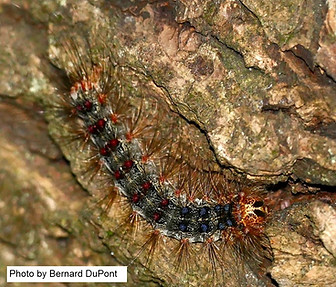Conservation District of the Year!
2412 Taft Road, Allegan, MI 49010
(269) 466-1140
Office Hours: Monday-Thursday 8:00am-4:00pm
INVASIVE SPECIES MANAGEMENT
The Allegan Conservation District is a proud member of the West Michigan Cooperative Invasive Species Management Area (WMCISMA) which provides assistance identifying, surveying, and treating populations of invasive species across 7 counties (Allegan, Kent, Mecosta, Montcalm, Muskegon, Newaygo, Oceana, Ottawa).
Contact the WMCISMA for more information on their services, help managing invasive species on your property.
Phone: 616-842-5852 ext: 5
Murielle Garbarino, WMCISMA Coordinator

Japanese Knotweed, photo courtesy of SEWISC
Hemlock Woolly Adelgid (HWA)
.jpg)
HWA is an invasive insect native to Japan. It extracts sap from hemlock trees, weakening needles, shoots, and branches. Over time, tree growth slows, and without treatment, infested trees die within 4-10 years. Hemlocks are some of the oldest living trees in Michigan, providing important habitat and winter cover for many species.
HWA can be identified by:
-
White, cottony masses about 1/4 the size of cotton swab attached to the twigs, at the base of needles on underside of branches
-
Needle loss and branch die back, no new growth
-
Gray-tinted foliage
Contact the WMCISMA for more information on their services, help managing invasive species on your property.
Phone: 616-842-5852 ext: 5
Murielle Garbarino, WMCISMA Coordinator
Spongy Moth Management
Outbreaks of spongy moth are not frequent but are unpleasant. Learn about why populations grow and collapse and how you can deal with their impact. Below are links and videos to help you decide how to manage your Spongy Moth outbreak.
The expert panel explores how Lymantria dispar (formerly Gypsy moth) became a naturalized resident in Michigan's forests. Dr. Deborah McCullough from Michigan State University, Dr. Steven Katovich of the USDA Forest Service, Susie Lott of MDARD and DNR's James Wieferich will cover the unusual history of this pest in the United States and here in Michigan, and what you can do to reduce some of the unpleasant impacts of an outbreak. You'll learn tips to help stressed trees recover from defoliation and options to help reduce the nuisance around your home.
Click the button below to watch this information-packed webinar.
This video was created prior to the insect's common name being changed to spongy moth. However it is a very educational video on how to manage spongy moth outbreaks yourself. Please click the button below to learn more.
A guide to Spongy Moth Egg Mass Surveying by Penn State Extension. Systematically survey egg masses of Lymantria dispar, or spongy moth (formerly "gypsy moth"), in fall and winter to assess the risk of damage next spring and decide whether aerially spraying control agents is worthwhile. Click the button below to continue your research.
The Great Lakes Entomologist breaks down how the Spongy moth (Lymantria dispar L.) (Lepidoptera: Lymantriidae) populations have recently spread into areas occupied by Karner blue in Michigan. Click on the button below to see how Btk treatment impacts the endangered Karner Blue Butterfly.











